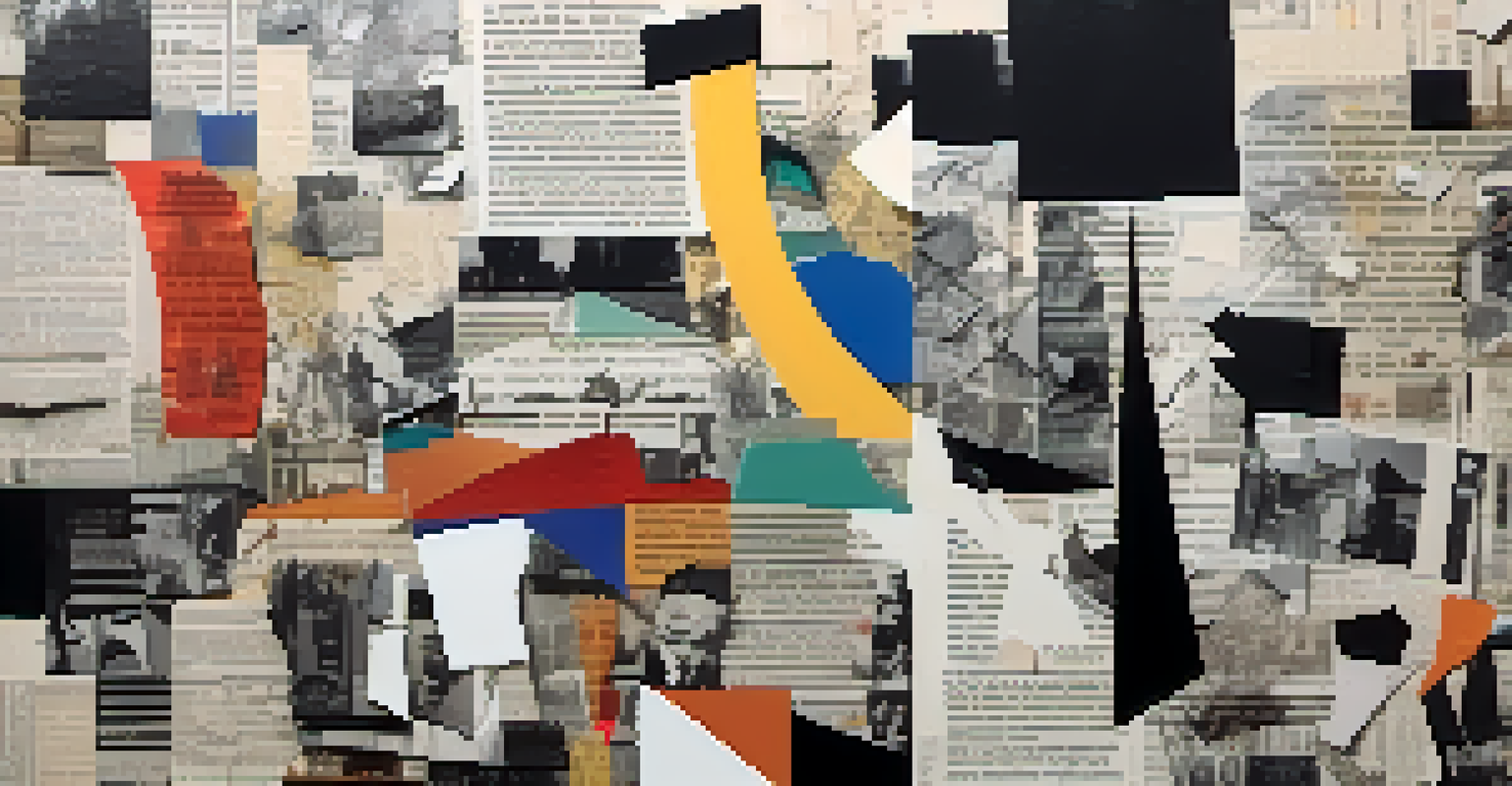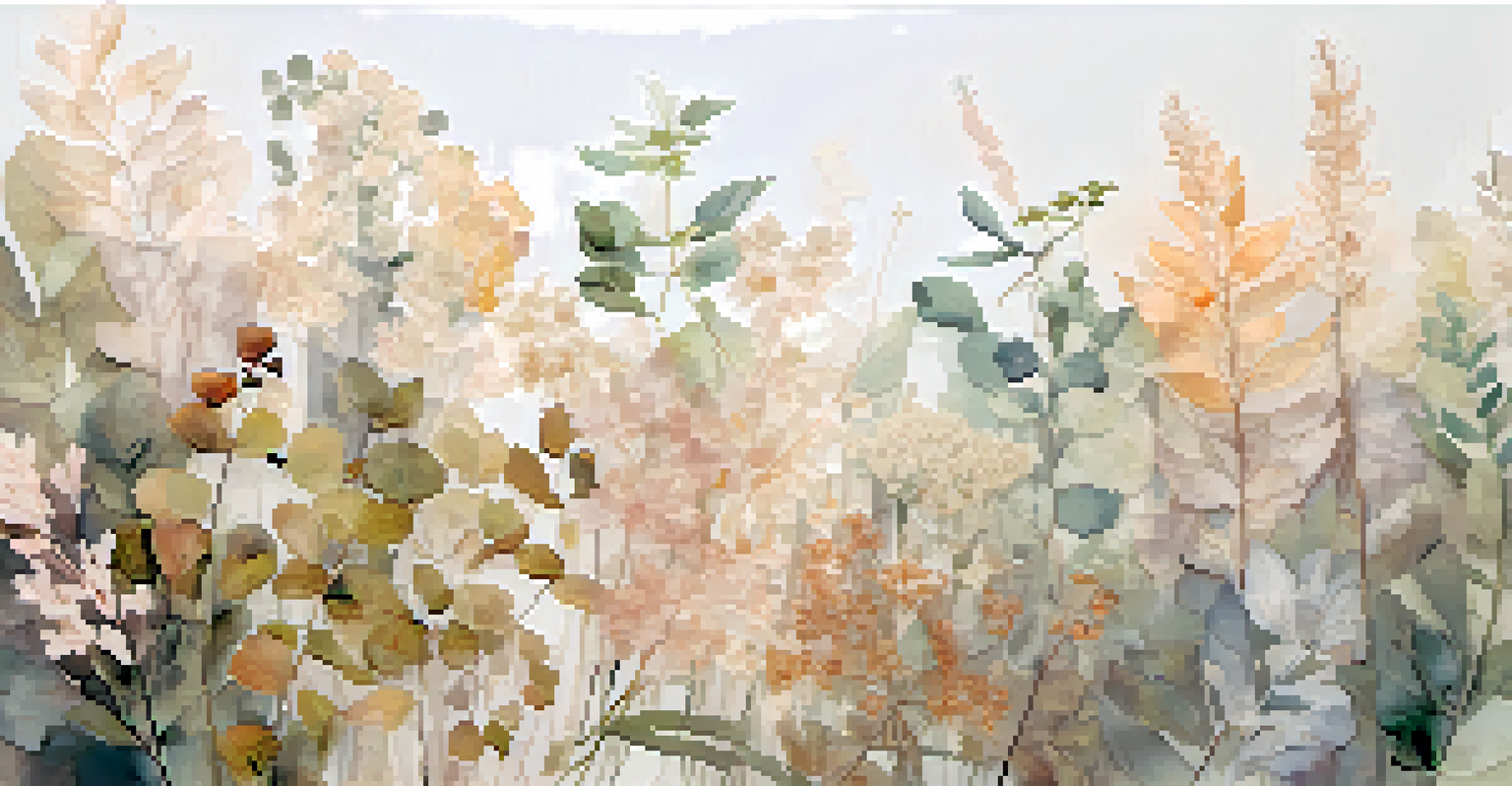The Use of Collage in Art to Explore Fragmented Memories

Understanding Collage as an Art Form
Collage is a unique art form where various elements are combined to create a new composition. It often includes cut-out images, photographs, and mixed media, allowing artists to express complex ideas. The beauty of collage lies in its ability to juxtapose different pieces, creating a narrative or emotion that might not be evident in a single image. This method of assembling various fragments resonates deeply with the theme of memory, particularly when memories themselves can be fragmented and disjointed.
Memory is the treasure house of the mind wherein the monuments thereof are kept and preserved.
Artists like Pablo Picasso and Hannah Höch were pioneers in the collage movement, using this technique to challenge traditional boundaries of art. They embraced the idea of incorporating everyday objects and images, transforming the mundane into the extraordinary. By doing so, they not only created visually striking pieces but also sparked conversations about identity, culture, and perception. This historical context sets the stage for modern artists who continue to explore these themes.
In today's digital age, collage has evolved, with artists using software to create intricate designs. This shift has opened up new avenues for expression, allowing for a blend of traditional and contemporary techniques. Whether through physical materials or digital platforms, the essence of collage remains the same: to explore and represent a reality that is often fragmented, much like our memories.
The Connection Between Collage and Memory
Memories are not always linear; they can be scattered and fragmented, much like the pieces in a collage. This disjointed nature of memory makes collage an ideal medium for exploring personal narratives. When artists create collages, they often reflect on their own experiences, piecing together various moments that may not follow a conventional timeline. This process can evoke feelings of nostalgia, loss, or even joy, as they make sense of their past.

For instance, an artist might use photographs from different stages of their life, combining them with text or other imagery to create a cohesive piece that tells a story. This blending of different times and places mirrors how our brains often recall memories—jumping from one moment to another without warning. By visually representing these transitions, artists can communicate the complexity of human experience.
Collage Reflects Fragmented Memories
Collage art mirrors the non-linear nature of memory, allowing artists to visually explore and connect personal narratives.
Moreover, the act of creating a collage allows artists to confront and reinterpret their memories. It becomes a therapeutic exercise, where they can reassemble their past and find meaning in the chaos. This therapeutic aspect highlights how collage not only serves as a form of artistic expression but also as a means of processing fragmented memories in a tangible way.
Collage Techniques that Evoke Fragmented Memories
Artists employ various techniques in collage to enhance the theme of fragmented memories. One effective method is using contrasting colors and textures to create visual dissonance, symbolizing the chaotic nature of memory. By placing different elements side by side, artists can evoke feelings of tension or harmony, reflecting how memories can coexist in our minds. This visual language invites viewers to engage with the artwork on a deeper level.
Art is the most beautiful of all lies, and the most honest of all truths.
Layering is another powerful technique in collage that emphasizes the complexity of memory. By overlapping images and materials, artists can create depth, suggesting that memories are not isolated events but rather interconnected experiences. This layered approach encourages viewers to explore the relationships between different elements within the artwork, mirroring how our memories are often interconnected and influenced by one another.
Additionally, incorporating ephemeral materials, such as newspaper clippings or ticket stubs, adds an element of temporality to the collage. These materials often carry personal significance, representing moments that may fade over time but are captured in the artwork. This use of found objects not only enriches the visual experience but also infuses the piece with a sense of authenticity, grounding it in real-life experiences.
The Role of Personal Narratives in Collage Art
Personal narratives play a crucial role in the creation of collage art, as artists often draw from their own life experiences. This personal connection adds layers of meaning to the artwork, inviting viewers to explore the artist's journey. For instance, an artist might include images from their childhood alongside more recent photographs, creating a dialogue between past and present. This narrative thread allows viewers to reflect on their own memories and experiences, fostering a sense of connection.
In many cases, artists use collage to process trauma or significant life events. By reconstructing their memories visually, they can confront emotions that may be difficult to articulate. This therapeutic aspect of collage not only aids the artist in healing but also resonates with viewers who may share similar experiences. The artwork becomes a safe space for exploration and understanding, transcending individual narratives to touch on universal themes.
Personal Narratives Enhance Collage
Artists often incorporate their own life experiences into collages, adding depth and inviting viewers to resonate with shared themes.
Furthermore, the act of sharing personal narratives through collage can foster community and dialogue. When artists exhibit their work, it often sparks conversations about shared memories and experiences, creating a sense of belonging. This communal aspect highlights the power of art to connect individuals through the exploration of fragmented memories, reminding us that we are not alone in our experiences.
Cultural Contexts and Fragmented Memories in Collage
Collage art also serves as a reflection of broader cultural contexts, where fragmented memories may emerge from collective experiences. For example, artists from marginalized communities often use collage to address historical events that have shaped their identities. By incorporating images and symbols relevant to their culture, they can create powerful statements that resonate with their audience. This cultural lens enriches the narrative within the artwork, adding layers of meaning beyond the personal.
In this way, collage becomes a tool for social commentary, allowing artists to reclaim their narratives and challenge dominant narratives. By piecing together fragments of their cultural history, they can highlight stories that have been overlooked or suppressed. This reclamation of memory is not only empowering for the artist but also educates viewers about the complexities of cultural identity.
Moreover, the blending of different cultural elements within a collage can symbolize the interconnectedness of human experiences. Artists may juxtapose images from various cultures, illustrating how memories and identities are not confined to one narrative. This celebration of diversity within collage art encourages viewers to embrace the richness of different perspectives, fostering a greater understanding of our shared humanity.
Contemporary Artists Pushing Collage Boundaries
As collage continues to evolve, contemporary artists are pushing its boundaries in innovative ways. Many are experimenting with mixed media, incorporating digital elements alongside traditional techniques. This fusion not only broadens the possibilities of collage but also reflects the multifaceted nature of modern life. Artists like Wangechi Mutu and Romare Bearden exemplify this blending of styles, using collage to address themes of identity, race, and memory.
Moreover, the rise of social media has transformed how artists share their collage work. Platforms like Instagram allow for immediate feedback and connection with audiences, fostering a sense of community among creators. This digital landscape also encourages collaboration, with artists often remixing each other's work to create new pieces. This collaborative spirit further enriches the narrative potential of collage, as it becomes a collective exploration of fragmented memories.
Cultural Contexts Shape Collage Art
Collage serves as a powerful medium for artists to reflect on collective cultural histories and challenge dominant narratives.
In addition, contemporary artists are increasingly using collage to engage with current social and political issues. By incorporating contemporary imagery and references, they can comment on the state of the world while still reflecting on personal and collective memories. This ability to address pressing topics through the lens of collage art ensures that the medium remains relevant and impactful, inviting viewers to reflect on their own experiences in relation to broader societal themes.
The Future of Collage in Exploring Memory
Looking ahead, the future of collage as a medium for exploring fragmented memories appears bright. As artists continue to experiment with new techniques and technologies, we can expect to see even more diverse representations of memory in their work. The rise of augmented reality (AR) and virtual reality (VR) may open up new dimensions for collage, allowing viewers to engage with the art in immersive ways. This evolution could transform how we perceive and interact with fragmented memories.
Additionally, as societal conversations around mental health and memory become more prominent, collage art will likely play a significant role in these discussions. Artists may increasingly use their work as a means of advocating for mental health awareness, sharing their personal journeys in a visual format. This could further enhance the therapeutic aspect of collage, providing a platform for healing and understanding.

Ultimately, the continued exploration of fragmented memories through collage will remind us of the power of art to reflect our experiences. As we navigate the complexities of memory in our own lives, collage will remain a vital medium for artists seeking to express and share their stories. By piecing together the fragments of our past, we can create a more cohesive understanding of who we are and the experiences that shape us.